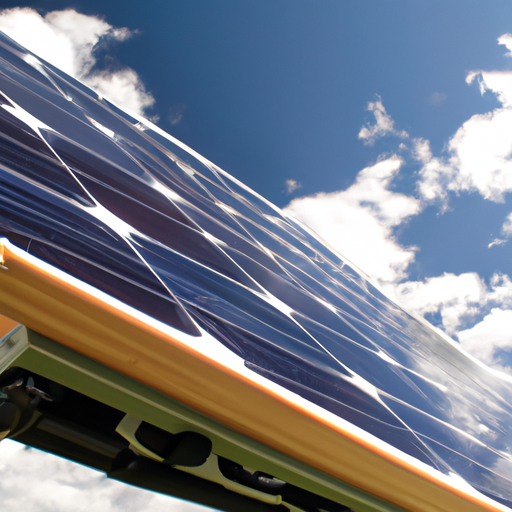

Have you ever wondered how much solar energy your portable solar panel can produce in different weather conditions? Well, you’re not alone! Many people want to know how to calculate the energy output of their solar panel, especially during cloudy or rainy days. In this article, we’ll dive into the details of how you can accurately calculate the solar energy output of your portable solar panel, no matter the weather.
When it comes to calculating the solar energy output, there are a few factors to consider. First and foremost, you need to understand the wattage rating of your solar panel. This information can usually be found on the back of the panel or in the manufacturer’s documentation. Once you know the wattage rating, you can use it as a base to estimate the energy output.
However, it’s important to keep in mind that the weather conditions play a significant role in the actual energy output of your solar panel. During sunny days, you can expect the panel to generate close to its rated wattage. On the other hand, on cloudy or rainy days, the energy output will be significantly lower. In some extreme cases, the panel may not produce any energy at all. To accurately calculate the solar energy output in different weather conditions, you’ll need to look at the solar irradiance levels for your location during those times. Solar irradiance refers to the amount of solar radiation that reaches the Earth’s surface, and it varies depending on factors like cloud cover and time of day.
In the next article, we’ll explore how you can use solar irradiance data to calculate the energy output of your portable solar panel in different weather conditions. Stay tuned!


What is a portable solar panel?
A portable solar panel is a device that converts sunlight into usable electrical energy. It is designed to be easily transportable and can be used to power various electronic devices or charge batteries. Unlike traditional fixed solar panels, portable solar panels are lightweight, compact, and can be easily folded or rolled up for convenience and ease of storage.
Definition of a portable solar panel
A portable solar panel consists of several photovoltaic (PV) cells, which are made of semiconductor materials such as silicon. These cells absorb sunlight and generate direct current (DC) electricity. The DC electricity is then converted into alternating current (AC) electricity using an inverter, making it suitable for powering a wide range of electrical devices.
Types of portable solar panels
There are different types of portable solar panels available in the market, each with its own features and specifications. The most common types include:
- Foldable solar panels: These panels can be folded into a compact size, making them highly portable and easy to carry. They often come with built-in handles or straps for convenience.
- Rollable solar panels: These panels are made of flexible materials and can be rolled up for transportation. They are lightweight and ideal for outdoor activities such as camping or hiking.
- Briefcase solar panels: These panels are designed to resemble a briefcase when folded, allowing for easy transportation. They often come with a built-in stand for optimal sunlight exposure.
- Backpack solar panels: These panels are integrated into backpacks, allowing users to charge their electronic devices while on the move. They are ideal for travelers or outdoor enthusiasts.
Advantages of using portable solar panels
Portable solar panels offer several advantages over traditional fixed solar panels:
- Portability: The main advantage of portable solar panels is their portability. They can be easily carried and used in various locations, making them ideal for outdoor activities or situations where access to electricity is limited.
- Versatility: Portable solar panels can be used to charge a wide range of devices, including smartphones, tablets, laptops, cameras, and even power banks. They provide a convenient and eco-friendly power source for both everyday use and emergencies.
- Off-grid capabilities: Portable solar panels allow users to generate their own electricity even in remote locations where access to the power grid is not available. This makes them highly useful for camping, RVing, or boating.
- Cost-effective: Portable solar panels offer a cost-effective alternative to traditional power sources, especially in the long run. They harness free and abundant sunlight to generate electricity, reducing the reliance on fossil fuels and lowering energy costs.
- Environmentally friendly: Using portable solar panels helps reduce carbon emissions associated with traditional electricity generation. They produce clean and renewable energy, contributing to a greener and more sustainable future.
- Easy installation: Portable solar panels are easy to set up and operate. They usually come with user-friendly instructions and require minimal maintenance. This makes them suitable for both beginners and experienced users.
Factors affecting solar energy output
Various factors can affect the output of solar energy from a portable solar panel. It is essential to understand these factors to accurately calculate the energy output and optimize the performance of the solar panel.
Sunlight intensity
The intensity of sunlight directly affects the amount of energy the solar panel can generate. Higher sunlight intensity results in increased energy output, while lower intensity leads to lower energy production. Factors such as time of day, season, and geographic location determine the sunlight intensity.
Temperature
Solar panels are sensitive to temperature changes. High temperatures can reduce the efficiency of solar panels and result in lower energy output. Conversely, lower temperatures can improve panel efficiency and increase energy production.
Cloud cover
Cloud cover can significantly reduce the amount of sunlight reaching the solar panel. Thick cloud cover or overcast skies can reduce energy output by blocking and diffusing sunlight. On the other hand, partial cloud cover may result in fluctuating energy production.
Shading
Shading can have a significant impact on solar panel output. Even partial shading of a single cell within a solar panel can lead to a drop in energy production. Shadows from nearby buildings, trees, or other objects should be avoided or minimized to maximize energy output.
Panel orientation
The orientation of a solar panel plays a crucial role in its energy output. Ideally, the panel should be positioned to face the sun directly to capture the maximum amount of sunlight. The tilt and angle of the panel can also affect its performance, especially in different seasons or latitudes.
Panel efficiency
The efficiency of a solar panel determines how effectively it can convert sunlight into electricity. Higher efficiency panels generally produce more energy compared to lower efficiency panels. Factors such as the quality of materials and manufacturing processes can impact panel efficiency.
Calculating solar energy output
Accurately calculating the solar energy output of a portable solar panel requires understanding various specifications and factors. Here are the steps to calculate the energy output:
Understanding solar panel specifications
Solar panels come with specifications such as peak power rating, maximum power voltage, and current. These specifications indicate the panel’s performance under ideal conditions and can be used as a reference for calculations.
Measuring panel efficiency
The efficiency of a solar panel is usually expressed as a percentage. To calculate panel efficiency, divide the panel’s peak power rating by the surface area of the panel. For example, if a panel has a peak power rating of 100 watts and a surface area of 1 square meter, the panel efficiency is 100 watts / 1 square meter = 100%.
Determining the solar panel’s wattage
To determine the solar panel’s wattage output, multiply its peak power rating by the panel’s efficiency. For example, if a panel has a peak power rating of 100 watts and an efficiency of 100%, the energy output is 100 watts * 1 = 100 watts.
Calculating daily energy production
To calculate the panel’s daily energy production, multiply the panel’s wattage output by the number of hours of sunlight received per day. For example, if a panel has an energy output of 100 watts and receives 5 hours of sunlight per day, the panel’s daily energy production is 100 watts * 5 hours = 500 watt-hours (Wh) or 0.5 kilowatt-hours (kWh).
Estimating energy output in different weather conditions
To estimate energy output in different weather conditions, it is essential to consider factors such as sunlight intensity, temperature, cloud cover, shading, and panel orientation. Adjustments can be made to the daily energy production calculation based on these factors. For example, during cloudy days, the energy output may be reduced by 20% due to reduced sunlight intensity.


Using solar radiation data
Solar radiation data provides valuable information on the amount of solar energy available in a specific location. This data helps in accurately estimating the energy output of a portable solar panel in different weather conditions.
Importance of solar radiation data
Solar radiation data helps determine the average amount of sunlight available per day in a specific location. It accounts for factors such as geographical location, climate, and seasonal variations, allowing for more accurate calculations of solar energy output.
Accessing solar radiation databases
Several organizations and websites provide access to solar radiation data. These databases offer information on average daily, monthly, and yearly solar radiation levels in specific locations. Users can input their location data to access relevant solar radiation data.
Interpreting solar radiation data
Solar radiation data is typically provided in kilowatt-hours per square meter per day (kWh/m²/day) or similar units. By comparing the solar radiation data with the panel’s efficiency and surface area, users can estimate the daily energy production of their portable solar panel in different weather conditions.
Accounting for varying weather conditions
Solar radiation data provides a baseline for estimating energy output. However, it is essential to consider real-time weather conditions and adjust the calculations accordingly. Factors such as temperature, cloud cover, shading, and panel orientation should be taken into account for accurate calculations.
Effect of temperature on solar panel output
Temperature can have a significant impact on the output of a solar panel. It is important to understand the temperature coefficient of solar panels and how to calculate temperature effects.
Temperature coefficient of solar panels
The temperature coefficient indicates how much the panel’s output power decreases per degree Celsius increase in temperature. It is usually specified by the manufacturer and can be a positive or negative value. A positive coefficient means the panel’s output power decreases with increasing temperature, while a negative coefficient means the output power increases.
Calculating temperature effects
To calculate the temperature effects on solar panel output, multiply the temperature coefficient by the change in temperature from the panel’s rated temperature. For example, if a panel has a temperature coefficient of -0.4% per degree Celsius and the temperature increases by 10 degrees Celsius from its rated temperature, the output power will decrease by 0.4% * 10 = 4%.
Mitigating temperature-related losses
To mitigate temperature-related losses, it is important to consider panel cooling techniques. These may include placing the panel in a well-ventilated area or using cooling devices such as fans or heat sinks to dissipate excess heat. Additionally, maintaining proper panel cleanliness and minimizing dust or dirt accumulation can help improve panel efficiency.
Impact of shading on solar panel output
Shading can significantly affect the output of a solar panel. It is crucial to understand the effect of shading, identify shading sources, and minimize their impact.
Understanding the effect of shading
Shading can cause a decrease in current flow within the solar panel, reducing its overall output. Even partial shading of a single cell can affect the performance of the entire panel. Shading can occur due to nearby structures, trees, or other objects that cast shadows on the panel.
Identifying shading sources
It is important to identify potential shading sources and ensure that the solar panel remains unobstructed throughout the day. Analyze the area where the panel will be placed and consider the movement of the sun and potential shading sources during different times of the day.
Minimizing shading effects
To minimize the effects of shading, place the solar panel in an area with minimal obstructions and shadows. Trim overhanging branches, relocate nearby objects, or adjust the panel’s position to ensure maximum sunlight exposure. If shading cannot be avoided entirely, consider using bypass diodes in the solar panel to mitigate the impact of shading on energy output.
Optimizing panel orientation
The orientation of a solar panel plays a crucial role in its energy output. By optimizing panel orientation, users can maximize energy production.
Ideal orientation for maximum energy output
The ideal orientation for a solar panel depends on the geographical location. In the Northern Hemisphere, panels should face true south, while in the Southern Hemisphere, panels should face true north. This ensures that the panel receives the maximum amount of sunlight throughout the day.
Angle adjustment for different latitudes
The angle of a solar panel should be adjusted based on the latitude of the installation location. The general rule is to tilt the panel at an angle equal to the latitude minus 10-15 degrees in the winter and equal to the latitude plus 10-15 degrees in the summer. This allows for optimal sunlight exposure during different seasons.
Using tracking systems for performance enhancement
Solar panel tracking systems can be used to further optimize energy production. These systems automatically adjust the angle and position of the solar panel to track the movement of the sun throughout the day. This ensures that the panel is always facing the sun directly, maximizing sunlight exposure and energy output.
Accounting for panel efficiency
Panel efficiency is an important factor that affects the energy output of a solar panel. It is important to consider panel efficiency ratings and factors that can influence efficiency.
Understanding efficiency ratings
Panel efficiency is typically expressed as a percentage and indicates how effectively the panel converts sunlight into electricity. Higher efficiency panels generate more energy compared to lower efficiency panels. When selecting a portable solar panel, consider the efficiency rating and choose panels with higher efficiency for optimal energy output.
Considering 1-sun condition
Solar panel efficiency ratings are often measured under standard test conditions, known as 1-sun conditions. This refers to a specific level of sunlight intensity that represents an average sunny day. However, actual sunlight intensity can vary, especially in different weather conditions. Therefore, it is important to consider this variation when calculating energy output.
Evaluating factors affecting efficiency
Various factors can affect the efficiency of a solar panel, such as dust or dirt accumulation, panel degradation over time, or mismatches between different panels in an array. Regular maintenance, such as cleaning the panel surface and ensuring proper installation, can help maintain or improve panel efficiency.
Calculating energy output for specific weather conditions
To accurately calculate the energy output of a portable solar panel in different weather conditions, specific factors should be considered for each weather scenario. Here are some examples:
Estimating energy production on a sunny day
On a sunny day with optimal sunlight intensity, the solar panel can operate at its maximum efficiency and produce its rated wattage output. Use the panel’s peak power rating, efficiency, and duration of sunlight to calculate the energy output for that day.
Calculating energy output on a cloudy day
On a cloudy day with reduced sunlight intensity, the energy output of the solar panel may be lower than its rated wattage output. Adjust the daily energy production calculation by a factor representing the reduction in sunlight intensity due to cloud cover.
Determining energy output during rainfall
During rainfall, the solar panel’s energy output may be significantly reduced or even temporarily halted due to the blocking effect of raindrops. Consider rainfall duration and intensity when estimating the impact on energy production. After the rain subsides, the panel’s energy output should resume.
Evaluating energy production in extreme weather
In extreme weather conditions such as storms or heavy snowfall, it is advisable to avoid exposing the portable solar panel to potential damage. These conditions may result in lower or no energy production and may pose risks to the panel. Prioritize safety and protect the panel from adverse weather conditions.
Conclusion
Accurately calculating the solar energy output of a portable solar panel in different weather conditions is essential for optimizing its performance and ensuring reliable power generation. By understanding factors such as sunlight intensity, temperature, cloud cover, shading, panel orientation, and efficiency, users can estimate the energy output with greater accuracy.
Portable solar panels offer numerous advantages, including portability, versatility, and cost-effectiveness. They provide a convenient and eco-friendly power source for various applications and can be used in a wide range of weather conditions. By accurately calculating the energy output, users can make informed decisions about the usage and placement of portable solar panels, maximizing their benefits and contributing to a sustainable energy future.



